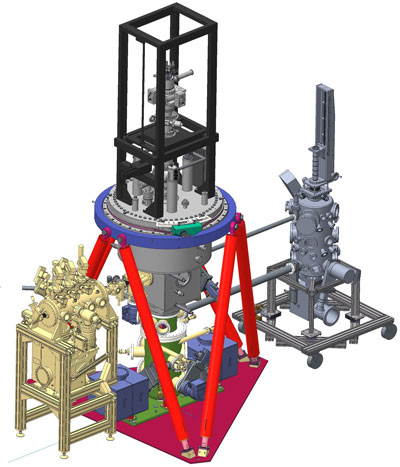| Posted: Jan 15, 2015 |
Vector electromagnet syytem creates 3D magnetic fields in samples
|
|
(Nanowerk News) Together with Helmholtz Zentrum Berlin (HZB), teams from the Universität Regensburg, from the Freie Universität Berlin and from the Ruhr Universität Bochum have jointly set up a unique measurement station at BESSY II: a vector electromagnet consisting of three mutually perpendicular Helmholtz coils which enables setting the local magnetic field at the sample position to any orientation desired. The first measurements of magnetic materials, spin systems, and nanostructured magnetic samples are scheduled for early 2015.
|
|
The heart of the VEKMAG measurement station was delivered to HZB at the end of last year: it consists of three Helmholtz coils arranged perpendicular to one another that create a magnetic field of the desired direction at every point in the ultra-high-vacuum sample chamber. The superconducting coils are made of a niobium-titanium alloy and cooled with liquid helium. The field strengths in the yz-plane of the sample surface are as high as two and one tesla respectively, and can reach up to nine teslas along the incoming beam direction (x-axis)
|
 |
| A general view of the VEKMAG end-station. The vector magnet chamber (grey) is supported by a hexapod frame. Below the magnet one can distinguish the detector chamber (green) and in the forward direction the deposition chamber (dark grey) is displayed. The beam quality is monitored by a diagnostic chamber (yellow) positioned in front of the magnet chamber. (Image: Dr. Tino Noll) (click on image to enlarge)
|
|
Six years research and development
|
|
“We have been working on this project for almost six years”, reports HZB physicist Dr. Florin Radu. He is coordinating the project with the three universities. The deposition chamber for the samples was designed at Freie Universität Berlin. Ruhr Universität Bochum built the detector chambers, and Universität Regensburg developed the concepts for synchrotron beam-based ferromagnetic resonance experiments.
|
|
Rapid change of polarisation
|
|
In the meantime, Radu and his team ensured optimum characteristics of a new beamline for carrying out most sophisticated experiments: “We need an extremely stable beam, but we also want to be able to change the polarisation of the x-rays very rapidly”, he explains. “For that reason, we developed a hexapod vacuum chamber with six moveable legs supporting a mirror. By changing the leg positions slightly, we can change the orientation of the first mirror and thereby the polarisation of the x-ray beam in just seconds – about one hundred times faster than before.” The tests show that this prototype arrangement improves the signal-to-noise ratio by a factor of more than ten.
|
|
Temperature between 1,6 K and 500 K
|
|
The new experimental station will not only facilitate many different kinds of studies, particularly in the soft X-ray region, but will also permit to carry out completely new studies that require temperatures of 500 Kelvin right down to 1.6 Kelvin and magnetic fields as high as nine tesla. Simultaneously the X-rays can penetrate the individual atoms and excite their outer electrons, enabling magnetic properties of the individual elements to be distinguished.
|
|
The main assets of the new VEKMAG end-station are experimental specifications that are unique in comparison with stations operating at other international facilities. In particular for element-specific and time-resolved measurements of ferromagnetic and paramagnetic resonances, as well as for spectroscopic and scattering experiments VEKMAG offers a unique sample environment. However, “VEKMAG will only attain its full potential, once HZB has implemented a new innovative beam filling pattern with variable pulse lengths at full photon intensities”, according to Radu, because “we can then investigate rapid spin dynamics with sub-picosecond time resolutions.”
|

